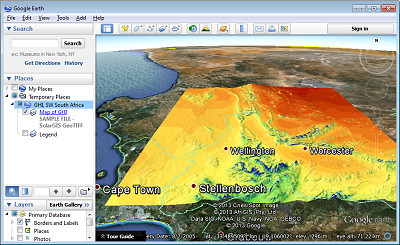Google Earth Geotiff
You can use the orto upload image or othergeoreferenced raster datasets in GeoTIFF or TFRecord format. (Seefor details on importing vectors using theCode Editor.) Uploading image assets GeoTIFFYou can upload image files up to 10GB in size to your Earth Engine user folder. To upload a GeoTIFF using the Code Editor,click the button, then select Imageupload. Earth Engine presents an upload dialog which should look similar toFigure 1. Click the SELECT button and navigate to a GeoTIFF on your localfile system.Give the image an appropriate asset ID (which doesn't already exist) in youruser folder.
If you'd like to upload the image into an existing folder or collection,prefix the asset ID with the folder or collection ID, for example/users/name/folder-or-collection-id/new-asset.Click UPLOAD to start the upload. The asset manager image upload dialog.Once you have started the upload, an 'Asset ingestion' task appears on the Tasks tabat the right side of the Code Editor. Hovering over the task in the task manager shows a? Icon which you can use to check the upload status. To cancel an upload,click on the spinning icon next to thetask.
Once the ingestion is complete, the asset will appear in your user folder witha image icon. TFRecordTo upload an image from a TFRecord file, you must have the associated mixer file thatwas generated when you exported imagery on which you performed inference. Seefor details on the mixer file. Morespecifically, to import predictions (as an image) made on exported imagery,. Export imagery into one or more TFRecord files. Perform inference on the imagery (i.e.
Model.predict). Write the output of model.predict into a TFRecord file. Thepredictions should be in the same order as the image exports on whichyou performed inference. Order can be enforced by a sort of the filenamesproduced by the export. See for details.
Upload the TFRecord file(s) and associated mixer to Earth Engine.Properties editingEdit asset metadata by specifying one or more metadata properties. In theProperties menu, click Add property todefine a property name and value (Figure 2). The value can be a string or a number.Enter strings without quotes. To format a number as a string, enter a single quote( ') before the number.By default, a system:timestartproperty is added with no value.
Google Earth Download
This property is used by Earth Engine when applyingImageCollection date filters. Enter either a date in the format shownin Figure 2, or a number representing milliseconds since January 1, 1970.

(Seefor more information on timestamps in Earth Engine).The Asset Manager interprets a number entered as the value for a property namedsystem:timestart or system:timeend as milliseconds andformats it as a date.Click thedeleteicon to remove a property. Advanced optionsIn the Advanced menu, choose the pyramiding policy and the masking modefor your data.The specifies how Earth Engine generates lower resolution versions of theimage. How do you apb reloaded cheats.
Google Earth Geotiff Import
Learn more about how Earth Engine handles multiple resolutions in the. Choose a 'Mean', 'Min', or 'Max' pyramiding policy tocompute lower resolution levels of the image pyramid as the mean, minimum or maximumof each 2x2 group of higher resolution pixels. This is a suitable option forcontinuous-valued images. For categorical (e.g. Land cover) or QA data, choose a'Sample' (the upper left pixel) or 'Mode' (most frequently occurring value, or sampleif there is no mode) pyramiding policy.The masking mode indicates how the uploaded image is(if at all). To specify a no-data value,select 'No-data value' and enter the value.
Pixels with this value will be masked in theuploaded image. This value is applied to every band of the image independently. To usethe last band of your image as a mask for the other image bands, select 'Use last bandas alpha band'. Theshould be anunsigned 8-bit band where 0 is masked (completely transparent) data and 255 iscompletely opaque. Tiled uploadsTo upload a single image as multiple tiles, where each tile is stored in a differentsource file, click Add another file to add additional files to theupload. Earth Engine will combine the tiles to create a single image in your userfolder.There are a few constraints on the types of files that can be uploaded into an imageasset. In particular:.
The images must have the same number of bands, bit depth, projection, resolutionand fill values. The offset from one file to the next must be an integer multiple of the pixel size. Gaps between tiles will be filled with masked pixels in the final image, so thetiles should ideally be adjacent and not sparsely spread out. Images with gapstaking up 99% of the image area won't be ingested.Send feedbackExcept as otherwise noted, the content of this page is licensed under the, and code samples are licensed under the.
For details, see the. Java is a registered trademark of Oracle and/or its affiliates.